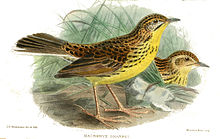Sharpe's
Longclaw population is suspected to be in rapid decline owing to the
human-driven loss of tussock grasslands. The rate of decline is expected to
become very rapid over the next three generations.
 Sharpe’s
Longclaw is classified as Endangered on the IUCN Red List and, between 2009 and
2012, the species was the focus for WLT’s Kinangop Grasslands Appeal. The
appeal successfully raised funds to save tussock grassland habitat for Sharpe's
Longclaw and for the many other threatened birds, reptiles and amphibians which
make Kinangop their home.
Sharpe’s
Longclaw is classified as Endangered on the IUCN Red List and, between 2009 and
2012, the species was the focus for WLT’s Kinangop Grasslands Appeal. The
appeal successfully raised funds to save tussock grassland habitat for Sharpe's
Longclaw and for the many other threatened birds, reptiles and amphibians which
make Kinangop their home.
Ranger
Andrew Mwangi Waweru manages a bird monitoring programme for Nature Kenya
In
the third quarter of 2015 Andrew monitored birds in three Nature Kenya
January 2016
No comments:
Post a Comment